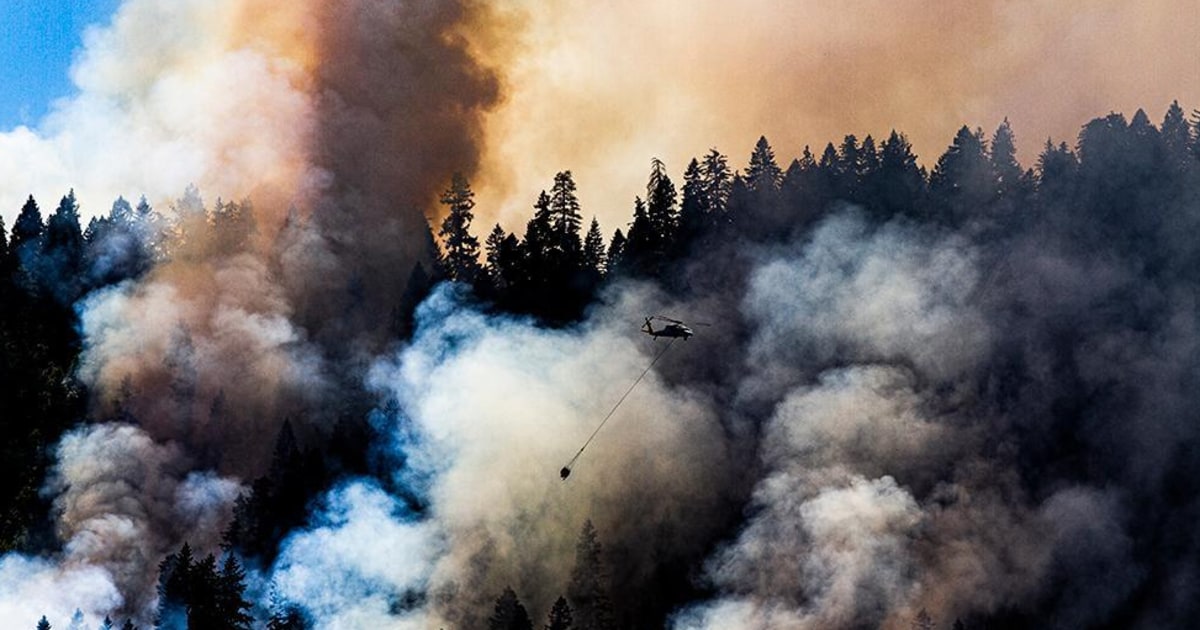
Fire officials hope a surge of hands on the perimeter of Oregon’s largest August wildfire can stop it before a heat wave and potential wind gusts multiply its size.
The 10,709-acre Rum Creek Fire has already doubled in size over the weekend, claimed the life of a firefighter, and burned one home to the ground, they said.
Fear over predicted 100-degree days and potential gusty winds is inspiring a scramble to clear and secure fire lines along the blaze’s back end, to the south, where thousands of homes could get fireside views if it reverses with the wind, officials said.
Additional fire crews that specialize in structure protection arrived at the fire Sunday, according the latest federal update. The total number of state-led structure-protection firefighters at the scene was 135, the update states.
“They are installing sprinkler kits, using hand tools to remove vegetation and other measures to better protect homes and outbuildings,” the update, published under the leadership of the U.S. Bureau of Land Management, said.
The wildfire 240 miles south of Portland is in an area that includes the Rogue National Wild and Scenic River and the Rand Recreation Area, both managed by the U.S. Bureau of Land Management.
The blaze is one of 42 active wildfires in the Southwest, California, the Pacific Northwest, Idaho, and Montana, according to the National Interagency Fire Center. More than 300,000 acres have been consumed by the blazes, it said a daily report Monday.
The center warned of “significant wildland fire potential” this week. For southwest Oregon, there is concern for structures south of the Rum Creek Fire.
“The concern for the next handful of days there’s triple digit temperatures in the forecast, and we’re going to see the potential for gusty winds that will push it south-southeast, into a very populated area,” said Kyle Reed, spokesperson for the federal and state response.
National Weather Service meteorologist Brian Nieuwenhuis said the shift that would have winds moving from north to south is likely Tuesday into the evening. Gusts could reach 20 mph.
“It’s looking pretty likely,” he said. “It’s not a strong wind, but it is a complete shift in direction. It would be blowing directly into populated areas.”
In the path of the fire, if it took a U-turn, is the resort town of Galice, named for Frenchman Louis Galice, said to have discovered gold in the area dominated by the Rogue River. The population of the unincorporated community was not tracked by the U.S. Census Bureau.
Residents of the nearby town of Merlin were told to stand by for possible evacuation orders, and boating on the Rogue River in the area of the fire was suspended by the Josephine County Sheriff’s Office.
Mandatory evacuations were in effect for areas along the perimeter of the fire.
State fire officials said 824 homes threatened by the Rum Creek Fire were the subject of defense efforts. More than 900 firefighters, managers and support personnel, including crews for four helicopters, were assigned to the blaze.
On Saturday, Gov. Kate Brown cited the threat to Galice and nearby Rand in giving the state fire marshal command of the fire and ordering local departments to contribute firefighters to the effort under mutual aid.
On Monday, she declared a state of emergency to ensure that Oregon is prepared for the worst amid a forecast of fire weather, including drier than normal conditions.
The worst includes what happened in 2020, when five blazes expanded beyond 100,000 acres and multiple other smaller wildfires raged during the month of September, claiming nine lives and burning thousands of structures, according to a state after-action review and NBC affiliate KGW of Portland.
The result was successful legislation last year that will provide more than $220 million for fire preparedness and modernization of firefighting tools and organizations.
Karl Koenig, president of the Oregon State Firefighters Council, a union that represents more than 3,500 state firefighters, emergency medical services workers, and other first responders, said the ashes of 2020 loom large in Oregon.
That year, firefighters across the state were spread perilously thin as they battled 1 million total acres of wildfire. The disaster inspired soul searching and a review of how fires are managed in the state.
Scrutiny after the fires helped produce a spirit of prevention and fast attacks based on the latest mapping and forecast modeling, which can seen in the fight against the current threat, Koenig said.
“We’re pouring into that Rum Creek Fire,” he said. “If it goes south, we’re talking thousands of homes. But it’s still at a manageable level. We’re able to concentrate resources and put them where they’ll be most effective.”
The blaze started Aug. 17 with a lightning strike and, the next day, claimed the life of firefighter Logan Taylor, 25, the operator of a private firefighting company contracted by the state, according to the Oregon Department of Forestry and Bureau of Land Management.
Officials said he was struck by a tree.
Taylor was the second firefighter to die after being struck by a falling tree in Oregon this month. Collin Hagan, 27, died Aug. 10 while fighting the Big Swamp Fire in Douglas County, Oregon, federal officials said.
On Monday, Oregon public institutions were under a gubernatorial order to fly flags at half-staff in remembrance of Taylor. “My heart breaks for the family, friends, and crew of Logan Taylor,” Gov. Brown said in a statement Friday.
The heat wave, fueled by a high pressure system over California and Nevada that was moving north, was forecast to strike southwest Oregon hardest Tuesday and sustain above-normal high temperatures in the area of the fire for most of the week.
On Tuesday high temperatures above the 100 degree mark were expected, according to the National Weather Service.
Relief was possible Friday with a minor cold front off the Pacific could move in and bring a reduction in temperatures of 5 to 10 degrees for the area of the Rum Creek Fire, Nieuwenhuis of the weather service said.
The weather change would be welcome, the forecaster said, if it didn’t include stiff winds from the Pacific.
“That would be a concern,” he said.
Source: | This article originally belongs to Nbcnews.com










